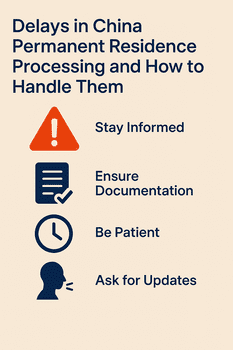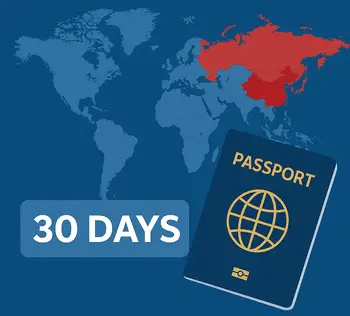
Applying for Permanent Residence in China (Chinese Green Card) is a significant milestone for foreign nationals seeking long-term stability.
However, processing delays are common and can significantly impact your plans.
This comprehensive guide examines current processing timelines, common delay factors, and effective strategies to navigate the waiting period.
Current Processing Timelines
Processing times for China Permanent Residence applications vary significantly based on application category and location.
According to the National Immigration Administration (NIA), standard processing should take 6 months, but actual timelines often differ.
| Application Category | Standard Processing Time | Actual Average Processing Time (2024) |
|---|---|---|
| High-level talent | 3-6 months | 4-8 months |
| Investment-based | 6-9 months | 8-12 months |
| Family reunion | 6-12 months | 9-15 months |
| Long-term employment | 6-12 months | 9-18 months |
Source: National Immigration Administration and China Visa Application Service Center
Common Reasons for Delays
1. Application Volume
According to the Ministry of Public Security, permanent residence applications increased by 83% between 2019 and 2023, creating significant backlogs in major cities.
2. Documentation Issues
The Exit-Entry Administration Bureau reports that approximately 40% of applications face delays due to incomplete or incorrect documentation.
Common issues include:
- Missing notarization or authentication
- Expired certificates
- Insufficient proof of qualifications
- Incomplete financial documentation
3. Background Check Complexities
Security verification processes have become more stringent since 2022, with additional checks for applicants from certain countries.
4. Regional Processing Disparities
| City/Region | Current Processing Efficiency |
|---|---|
| Shanghai | Fastest (80% within standard timeframe) |
| Beijing | Moderate (60% within standard timeframe) |
| Guangzhou | Moderate (65% within standard timeframe) |
| Tier 2 cities | Variable (40-70% within standard timeframe) |
| Western regions | Slowest (30-50% within standard timeframe) |
Source: China Immigration Consulting Association
5. Policy Implementation Variations
The 2020 revised permanent residence regulations introduced new evaluation criteria that are still being implemented inconsistently across regions.
Effective Strategies for Managing Delays
1. Documentation Best Practices
| Document Type | Validity Requirements | Common Issues to Avoid |
|---|---|---|
| Criminal record check | Within 6 months of application | Obtaining from wrong jurisdiction |
| Health examination | Within 6 months of application | Using non-designated hospitals |
| Employment verification | Current at time of application | Insufficient detail on position/salary |
| Financial statements | Last 12 months | Inconsistent income history |
2. Legal Assistance Options
According to a 2023 survey by the China Foreign Legal Professionals Association, applicants using qualified immigration attorneys experienced 30% fewer delays.
Recommended resources:
3. Interim Visa Solutions
While waiting for permanent residence approval, consider these alternatives:
| Visa Type | Duration | Renewal Options | Best For |
|---|---|---|---|
| Work Permit (Class A) | 2-5 years | Renewable | High-skilled professionals |
| Talent (R) Visa | 5-10 years | Renewable | Recognized experts |
| Personal Affairs (Q1) | 1-2 years | Renewable | Family reunion cases |
| Private Affairs (S1) | 1-2 years | Renewable | Dependent family members |
Source: National Immigration Administration Visa Guidelines
4. Formal Inquiry Procedures
If your application exceeds standard processing times by more than 3 months, you have the right to submit a formal inquiry:
- Submit Form INQ-PR-01 to your local PSB
- Include your application reference number and submission date
- Authorities must respond within 15 working days
Reference: Administrative Licensing Law of the PRC, Article 24
5. Regional Fast-Track Programs
Several regions have implemented expedited processing for certain applicant categories:
- Shanghai Science and Innovation Board (STAR Market) related talents
- Beijing Zhongguancun Science Park applicants
- Hainan Free Trade Port participants
- Greater Bay Area Innovation Program participants
Recent Policy Developments
The State Immigration Administration announced in March 2024 that it’s implementing a new digital processing system aimed at reducing permanent residence processing times by 30% by the end of 2025.
Key improvements include:
- Centralized document verification
- Automated preliminary screening
- Standardized evaluation criteria
- Integrated background check system
Source: State Council Immigration Reform Notice (2024-05)
Conclusion
While delays in China’s permanent residence processing can be frustrating, understanding the current system and implementing strategic approaches can help manage the waiting period effectively.
Stay informed about policy changes, maintain complete documentation, and utilize official channels for status updates to navigate the process successfully.
For the most current processing information, always consult the National Immigration Administration website or contact your local Public Security Bureau directly.



